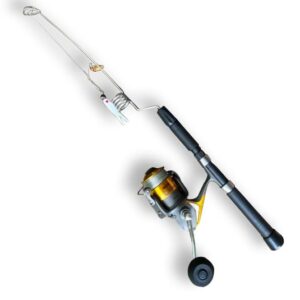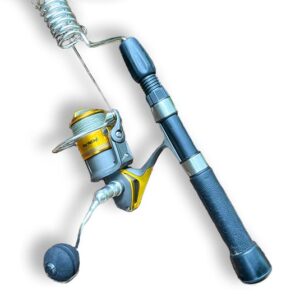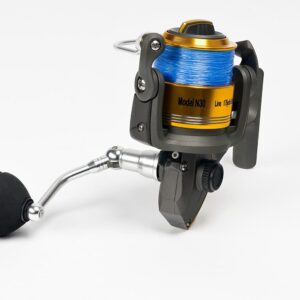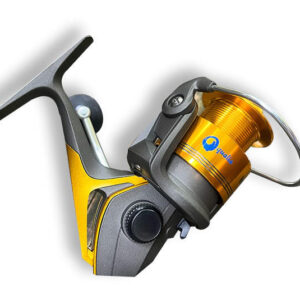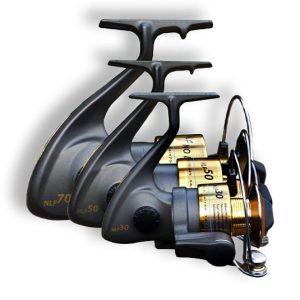What Are Reel Sizes?
Reel sizes are used to indicate the size of a reel, spool, or drum. The reel sizes used in the industry are known as standards. Generally speaking, the smaller a reel is, the more difficult it is to use and the larger the reel, the easier it is to use.
Spinning Reel Sizes – Choose The Best Size Reel For Your Purpose
If you are looking for a spinning reel, the size of your reel will determine the kind of fishing you are going to do. There are many kinds of spinning reels available in the market. These include simple and high-performance spinning reels. The first type is used by beginners while the second is more suitable for professional fishers. Let’s look at each one of these options before we proceed to buy one!
The Qualia NLF 30 reel is a great beginners reel as it can handle fish from bait size to true great pan fish size. The reel is lightweight, powder coated for protection from the saltwater environment, handle can move from either side for right or left-handed use.
If you want me to recommend my favorite, I would go for an NLF 50 No Load Spinning Reel which has proven itself fantastic in many situations and will last for years if well taken care of. It comes at less than $90, so it’s pretty cheap too!
The Qualia NLF 70 reel is a high performance reel with dual anti reverse cams, and a rating of up to 20 pounds of drag. This reel is used for even bottom fishing for grouper and snapper, besides large mahi, kingfish, and sailfish.
What size spinning reel do I need?
The first thing to consider is the size of the fish you are targeting. The next question is what type of fishing do you want to do? For example, if you have a family or friends who enjoy fly-fishing, then it’s likely that they’d like to use their own spin rods for this sport. If that’s the case, then you’ll need a rod with a spinning reel attached. On the other hand, if your family loves saltwater fishing and can’t get enough of catching tarpon from their boat, then perhaps they’d prefer using an electric reel and casting line instead.
Spinning reels are available in all sizes and styles depending on how much line capacity you need and whether or not there is any weight requirement on your reel as well. Most people will want at least 6-10lb test monofilament line per spool because it provides plenty of line strength for most species of fish including steelhead trout, salmon and redfish. However, if you need a heavier line for long casts, then consider using 10-20lb test monofilament line per spool because this line will last much longer.
Spinning reels come in all different sizes, so it’s important to take measurements before you make your decision. You’ll want to find a reel that fits inside your rod holder or on the floor of your boat as close as possible without making contact with the back of your seat or running into an overhead console. If you’re fishing from shore and don’t have any room at all between the reel and front seat back support, try buying one that is slightly larger than what you can fit into your rod holder. When selecting the right size spinning reel for yourself, always ask yourself how often you plan on fishing and whether or not there will be weight requirements on the reel itself. The more weight required by the fish being caught, the larger the size of spin rod is likely to be needed by said fish.
Rod Holders:
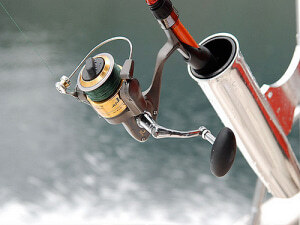
Spinning rods are typically stored in a vertical orientation when they aren’t in use; however some anglers prefer storing their rods horizontally because it makes them easier to reach. In the case of vertical rod holders, it can be tricky to store a spinning reel in this orientation as you will have trouble reaching the handles of the reel with your arms if they are positioned horizontally. For this reason, many anglers opt for horizontal rod holders which hold their rods vertically and allow them to easily reach the handles of their reels without having to bend over or look down at the ground.
Spinning reel sizes explained :
Spinning Reels are the most popular type of baitcaster reel. They have a single handle and a spool that is larger than the line, which makes them easier to cast, and they are more sensitive when reeling in your catch. The downside to these reels is that you can’t use super-light line with it; typically between 8-10lb test, but some spinners can be used on lighter lines as well (check product specifications). If you want even more sensitivity or better casting range then I would recommend going for an ultra-light spinning reel like a Rio Rio Grande. There are also some spinning reels that have a second handle on the side of the reel for extra casting control.
The next type of baitcaster is the fixed spool. This is a more advanced type of baitcasting reel because it has two handles, and you can adjust how much line comes off each handle as well as what kind of drag system you want to use (i.e. rear-click/center-click). They are more expensive than spinning reels but they make it easier to set your drag system and get better casting distance and sensitivity out of your lure or rig.
Spinning Reels vs Fixed Spools: Which One Should You Get?
I think both types are great depending on what you plan on using them for . I think a spinning reel is better for fishing in the surf where you can cast further and have greater casting distance. But if you are going to be using your reel in deeper water then a fixed spool would be a good choice because it will give you more drag control and make it easier to set your drag system.
Some people also like to use their baitcaster as an anchor point when they fish rivers and lakes, which is why some of them come with a reverse clicker on the side so that when you put down the rod tip, the baitcaster immediately starts reeling in line without having to pull back on the handle or bump up against something while doing so.
Qualia spinning reel size chart
| Reel Size | Weight | Line Length | Line Mono | Recommended For |
| NLF-30 | 12.7 oz | 240 yd | 8 lb | Light Fishing For Inshore and Offshore |
| NLF-50 | 18 oz | 240 yd | 14 lb | Medium Fishing for Inshore and Offshore |
| NLF-70 | 22.8 oz | 240 yd | 20 lb | Medium/Heavy Fishing for Inshore and Offshore |
How do you match a spinning reel with a rod?
As you know, there are many factors that determine the effectiveness of a reel. For example, some reels have more drag than others and can be matched with rods that do not have enough resistance to handle the added drag. Some reels will function best with a heavier line or rod whereas other reels may require a light line or lighter rod. There is no one right answer for every angler so it’s important to experiment and test different combinations until you find what works best for your fishing style and technique.
When choosing your spinning reel, consider the following: Line Weight: The weight of the line is important because it determines how much drag your reel will produce. If you have a lighter line, then you would need to use more effort when reeling in your fish so choose a reel that has less drag and is matched with a rod that can handle more resistance.
The weight of the line is important because it determines how much drag your reel will produce. If you have a lighter line, then you would need to use more effort when reeling in your fish so choose a reel that has less drag and is matched with a rod that can handle more resistance. Line Length: Another factor to consider when choosing your spinning reel combo is the length of the fishing line. Some reels are compatible with longer lines than others, which means they may be able to take heavier lines or even bigger hooks for larger predator species such as tuna or marlin and thus putting less stress on your rod tip than some other types of reels could.
Another factor to consider when choosing your spinning reel combo is the length of the fishing line. Some reels are compatible with longer lines than others, which means they may be able to take heavier lines or even bigger hooks for larger predator species such as tuna or marlin and thus putting less stress on your rod tip than some other types of reels could. Line Mono: Some reels can use either mono or braided line whereas most baitcasters require monofilament line. If you have a higher-end spinning reel but only have a lower-end mono line then you will need to buy an extra spool of mono so that you can change it out during the course of your day without having to go back to camp each time.
Shop Qualia Spinning Reels
-
Kayak King II Rod Package$319.95
-
Emmrod Packrod Spin Rod N30 Package$279.95
-
N30 No Load Spinning Reel$175.00
-
N50 No Load Spinning Reel$195.00
-
NLF-70 No Load Spinning Reel$99.99
-
NLF-50 No Load Spinning Reel$85.99
